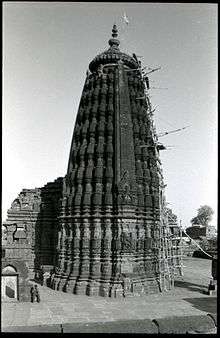Udaipur, Madhya Pradesh
Udaipur is a town in the Indian state of Madhya Pradesh near Ganj Basoda. It is the site of a well-preserved Śiva temple, a monument of national importance protected by the Archaeological Survey of India.
Udaipur | |
|---|---|
town | |
 Udaipur Location in Madhya Pradesh, India | |
| Coordinates: 23.900177°N 78.056655°E | |
| Country | |
| State | Madhya Pradesh |
| District | Vidisha |
| Languages | |
| • Official | Hindi |
| Time zone | UTC+5:30 (IST) |
| PIN | 464221 |
| Telephone code | 91-7594 |
| Vehicle registration | MP-40 |
History
Udaipur's history reaches back to at least the ninth century, but it became famous and appears to have assumed its present name under the Paramāra king Udayāditya (c. 1060-87).[1] It continued to be important in the 14th, 15th and 16th centuries, and was an important town on the north-south trade route.
Geography
Udaipur is located at 23°54'2"N 78°3'29"E.
Transport
Udaipur is connected by bus service from Ganj Basoda railway station 93 km from Bhopal Junction towards Jhansi (203 km) and 604 km from New Delhi Jn.
Monuments

The monuments of Udaipur were first studied by M. B. Garde and published in the reports of the archaeological department of Gwalior state. The data in these reports was compiled into a list prepared in 1952.[2]
Śiva temple
The most important temple at Udaipur is that dedicated to Śiva and known today as the Nīlakaṇṭheśvara. It was built in the second half of the eleventh century and is the only surviving royal temple of the Paramara kings. An inscription in the eastern porch records the building of the temple in Vikrama Saṃvat 1137 or 1080-81 CE.[3] Architecturally, the temple spire belongs to a class known as bhūmija, or 'earth born,' a mode of temple building that originated in the Mālwa region.[4]
The complex Śaiva iconography of the temple has been studied by Doria Tichit.[5]
In the entrance porch of the temple are series of more than sixty votive records.[6] Not yet studied in a systematic fashion, these form a continuous sequence from the time of the Paramāras – Devapāla (1218–39) is mentioned – through the period of the Tughluqs and beyond. For example, one inscription mentions a festival (yātrā) of the god Udaleśvara in 1338, the same year as the Tughluq inscription recording the construction of the mosque in the temple precinct.[7]
Tughluq Shahi mosque
Directly next to the temple is a small mosque constructed during the reign of Muhammad ibn Tughluq. A pair of inscriptions record the building of this structure in AH 737 and 739 AH (i.e. 1336-37 and 1338-39 CE).[8]
Islam Shah Suri mosque
A short distance to the south of the Shiva temple is a mosque with an inscription recording its construction in the time of Islam Shah of the Sur Dynasty in 1549.[9] The inscription is placed directly over the mihrab.[10] The shows the continued importance of Udaypur on the north-south route to the Deccan in the time of the Suri rulers. Despite its importance and uniqueness, the authorities have let the monument fall into ruins.
References
- Arvind K. Singh, "Interpreting the History of the Paramāras," Journal of the Royal Asiatic Society 3, 22, 1 (2012), pp. 13–28. Online version: http://journals.cambridge.org/action/displayJournal?jid=JRA
- D. R. Patil, The Descriptive and Classified List of Archaeological Monuments in Madhya Bharat (Gwalior: Dept. of Archaeology, Madhya Bharat Government, 1952).
- "Foundation record of the Udayesvara temple". SIDDHAM: the Asia Inscriptions Database. Retrieved 19 Feb 2020.
- Krishna Deva, "Bhumija Temples," in Studies in Indian Temple Architecture, ed. P. Chandra (Delhi: AIIS, 1975): 90-113; Adam Hardy, Theory and Practice of Temple Architecture in Medieval India: Bhoja's Samarānganasūtradhāra and the Bhojpur Line Drawings, with translations by Mattia Salvini (New Delhi: IGNCA, 2015)
- Doria Tichit, "Le programme iconographique du temple d’Udayeśvara à Udayapur, Madhya Pradesh, XIe siècle," Arts asiatiques 67, no. 1 (2012): 3-18. Available online: http://www.persee.fr/doc/arasi_0004-3958_2012_num_67_1_1770.
- The records are listed in Annual Report on Indian Epigraphy (1961-62), section C, nos. 1611-1677.
- Annual Report on Indian Epigraphy (1961-62), section C, no. 1625.
- A. Cunningham, Archaeological Survey of India Reports, vol. 10, p. 68; D. R. Patil, The Descriptive and Classified List of Archaeological Monuments in Madhya Bharat (Gwalior: Dept. of Archaeology, Madhya Bharat Government, 1952): no. 1692; Indian Archaeology: A Review (1983-84), p. 56.
- Rahim, Syed Abdur (2000). Arabic, Persian and Urdu inscriptions of Central India : a topographical list. New Delhi: Sundeep Prakashan. p. 123.
- "Udaypur उदयपुर (Madhya Pradesh). Arabic and Persian inscription (INAP00005)". SIDDHAM: the Asia Inscriptions Database. Retrieved 18 Feb 2020.